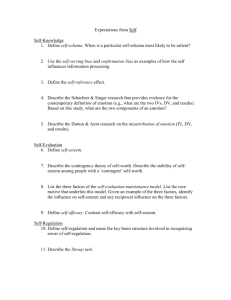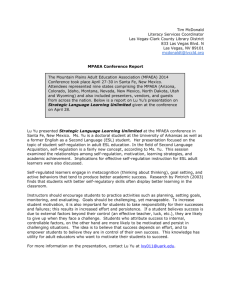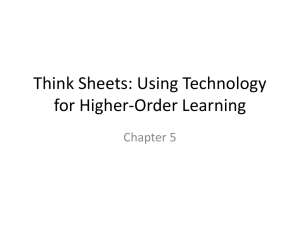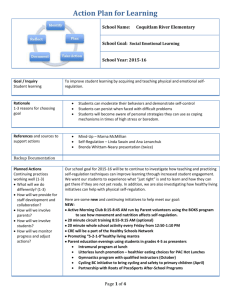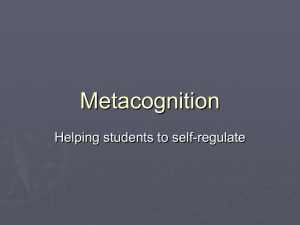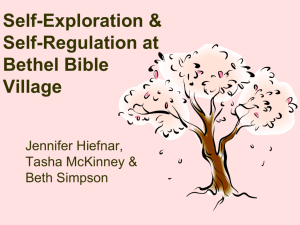Self-Regulation in Children Birth - Five
advertisement
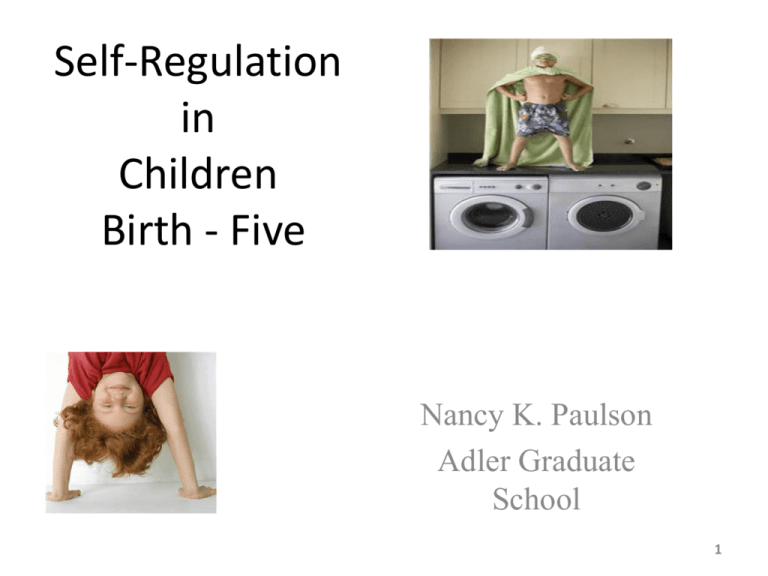
Self-Regulation in Children Birth - Five Nancy K. Paulson Adler Graduate School 1 Objectives • To give an overview of self-regulation from birth through age five • To provide interventions that build selfregulation in young children • To provide activities & resource information that repair self-regulation 2 Definition of Self-Regulation • The control or organization of behavior • Active suppression process engaged for the purposes of pursuing a goal • Involves control over a variety of processes 3 Definition of Self-Regulation (Jahromi and Stifter,2008) • Emotion regulation • Behavioral control • Executive function 4 Examples of Self-Regulation • Complies with requests • Initiates and/or ceases activities • Modulates intensity, frequency & duration of verbal & motor acts • Postpones actions 5 Examples of Self-Regulation • Generates socially approved behaviors (Boyer, 2009) • Remembering & following directions • Remembering class rules • Persisting on a difficult task 6 Examples of Self-Regulation • Planning solutions to a problem • Stopping impulsive response in favor of adaptive behavior • Soothability • Focusing on a task while ignoring distractions 7 Marshmallow Test • VIDEO: • Marshmallow Test: https://www.youtube.com/watch?v=6EjJsPylEOY 8 Adlerian Lens (Adler, 1956) • Alfred Adler 1870-1937; ophthalmologist/GP MD developed psychological interests • Contemporary of Freud • Believed behavior is goal directed 9 Adlerian Lens (Adler, 1956) (cont.) • Lifestyle is built on “mistaken beliefs” • Foundation laid by early interactions with others in the first five years of life • Social interest 10 Goals of Misbehavior • Attention Connect Cooperation • Power Capable Self-Reliance • Revenge Count Contribution • Avoidance Courage Resiliency The Crucial C’s and Rudolf Dreikurs’ 4 Short-Range Goals of Misbehavior . From A parent’s guide to understanding and motivating children. Newton Centre, MA: Connexions Press. Used with permission. 11 Fifth Goal of Misbehavior •May need to add a goal due to current family risk factors: • Safety Care Valued 12 Cultural Bias (Bronson,2000) Western influence: • Values independent effort • Achievement • Self-reliance • Personal responsibility 13 Example • Goal Directed Behavior • VIDEO: Fake Crying; trying to avoid bedtime: http://www.youtube.com/watch?v=r7zxQllsd9E 14 Effects of Poor Self-Regulation • Family disruptions • Expulsion (Gilliam and Shahar, 2006) • School readiness (Blair and Diamond, 2008) • Medication (Zito et al., 2000, Stanwood & Levitt, 2004) 15 Factors in Development of Self-Regulation • Caregiver fit • Sensitive, gentle guidance • Modeling and coaching of language use • Encouragement of responsibility (Dennis, 2006) • Modeling positive behaviors 16 Factors in Development of Self-Regulation (cont). • Positive reinforcement enhancing children’s desire to try new and more challenging tasks • Language development • Structured environmental support Factors in Development of Self-Regulation (cont). • Ability to shift from external to internal control • Symbolic play and language use • Private speech • Secure Attachment Secure Attachment • Available and responsive mothers as a secure base • Dependable presence (Ainsworth, Bell, 1978, Bowlby, 1958)) 19 Infant Attachment • Repeatedly associated in regulatory development from emotional arousal to cognitive abilities (Kochanaska, Philibert, & Barry, 2009) • Enhances ability to develop self-calming strategies (Florez, 2011) 20 Deterrents to Self-Regulation • Poverty • Maternal depression • Chaotic, over-stimulating or understimulating environment • Physical or sexual abuse • Difficulties with sleep-wake cycle (Conway, 2009) 21 Deterrents to Self-Regulation • Failing to provide challenging opportunities • Developmental delays • Temperament • Language delays/lack of language experiences 22 Deterrents to Self-Regulation • Parental misunderstanding of appropriate developmental expectations • Negative, insensitive or unresponsive caregivers who model controlling behavior rather than encouraging limited autonomy (McClelland and Cameron, 2011) • Punishing young children when failing to sustain attention longer than a few minutes or fail to calm themselves quickly when frustrated (Florez, 2011) Deterrents to Self-Regulation • Use of coercive control (Bronson, 2000) • Absence of positive experiences (Gearity, 2009) • Lack of private speech • Language delays (Qi and Kaiser, 2004) 24 Support & Interventions • Good news • Self-Regulation is a teachable skill • Self-Regulation serves as a protective factor with low parental warmth or negative parenting (McClelland & Cameron, 2011) 25 Developmental Repair (Gearity, 2009) • Co-Regulation • Repair occurs within relationship context • Focus on development not behavioral control 26 Developmental Domains Relating, Thinking, Feeling, and Acting • An effective co-regulator: • Externally models and reflects words • Resists the assumption that children are cognitively aware of their behavioral choices • Provides the opportunity for children to become aware of thoughts, feelings, and resultant actions. 27 Developmental Domains Relating, Thinking, Feeling, and Acting (cont.) • Children are understood then gain insight into others • Understanding emotions results in better management of emotional and behavioral upset 28 Tools for Co-Regulators (Gearity, 2009) • • • • • • Be quiet Breathe slowly Eye contact or not Verbally match Stay in the present Appropriate calming touch 29 Tools for Co-Regulators (cont.) • Remain physically nearby • Find distractions to share • Shifting attention • Repetitive play • Physical movement • Recognize return to less aroused state • Admire the accomplishment • Positive emotional support 30 Co-Regulation Approaches (Vallotton & Ayoud, 2011) • Encourage young children to talk aloud when solving difficult problems • Encourage breadth of spoken vocabulary • Vocabulary vs. talkativeness • “Spoken words are mental tools with which to regulate oneself by exerting control over one’s own thought, emotions, and behavior, and perhaps one’s environment” (p.179). 31 Emotion Mentors (Boyer, 2009) • Help connect behavior to response • Model, teach, encourage identification of verbal & non-verbal cues. 32 Emotion Mentors (Boyer, 2009) (cont.) • Toddlers • • • • • • • • Comforting language Gentle movements Gestures of concern Help recognizing negative emotions Help attach feeling with pictorial form Help knowing “why” of anger Help reorganizing escalating anger Use reflective language 33 Emotion Mentors (Boyer, 2009) (cont.) • Four year olds • • • • • • • Help recognizing signs of distress Modeling & encouraging acts of kindness Invitations to practice kind behaviors Reflective language Help recognizing escalating anger Model problem solving Verbal recognition of feelings and why of feelings 34 Emotion Mentors (Boyer, 2009) (cont.) • Five and Six year olds • Support in distress recognition • Encourage taking responsibility for behavior • Give opportunities to think about own/others emotions • • • • Realize they have emotions Identify varied emotions Learn appropriate emotion expression Talk about how they feel when expressing emotions 35 Emotion Mentors (Boyer, 2009) (cont.) • Five and Six year olds • Encourage Social Interest • • • • Taking the perspective of another Emotion influence on others Conflict resolution & social problem solving Respect for self, others, & other’s work 36 Activity Domains Targeting Self-Regulation (Bobula, 2009) • Inhibitory Behaviors • Attention • Planning, organizing, & creating 37 Activities • Games: • • • • • • • Red Light, Green Light Duck, Duck, Goose (Grey Duck) Statue Freeze Tag Run & Stop Picture Bingo Simon Says Musical Chairs 38 Activities • Songs/Finger Plays • • • • • • The Freeze & Movement Song – Steve & Greg Bear Hunt – Dr. Jean Head & Shoulders, Knees & Toes Where is Thumbkin? Hokey Pokey B-I-N-G-O 39 Activities • Fidget Toys • Constructive • • • • Dramatic play – (at least 30-60 minutes) Block building Painting Drawing 40 Helpful Resources • http://www.washburn.org/about/WashburnPubl ishesTrainingManual.html • http://csefel.vanderbilt.edu/index.html • http://www.developingbrains.org 41 Summary • Self-Regulation is a critical developmental process • Self-Regulation is a teachable/learnable skill • Utilize the tools, activities, and resources that encourage self-regulatory development 42 References • Adler, A. (1956). H. L. Ansbacher & R. R. Ansbacher (Eds.), The Individual Psychology of Alfred Adler New York, NY: Harper & Row. • Ainsworth, M., & Bell, S. M. (1970). Attachment, exploration, and separation: Illustrated by the behavior of one-year-olds in a strange situation. Child Development, 41(1), 49-67. • Blair, C., & Diamond, A. (2008). Biological processes in prevention and intervention: the promotion of self-regulation as a means of preventing school failure. Developmental Psychopathology, 20(3), 899-911. doi: 10.1017/S0954579408000436 • Bobula, K. A. (2009). Developing brains: Ideas for parenting and education from the new brain science. Retrieved from http://www.developingbrains.org • Boyer, W. (2009). Crossing the glass wall: Using preschool educators’ knowledge to enhance parental understanding of children’s self-regulation and emotion regulation. Early Childhood Education Journal, 37(3), 175-182. doi: 10.1007/s10643-009-0343-y 43 References • Bowlby, J. (1958). The nature of the child's tie to his mother . International Journal of Psycho-Analysis, 39, 350-373. • Bronson, M. B. (2000). Self-regulation in early childhood. New York: The Guliford Press. • Conway, A. (2009). Neurophysiological basis of self-regulation in children and youth. Reclaiming Children and Youth, 17(4), 16-22. • Dennis, T. (2006). Emotional self-regulation in preschoolers: the interplay of child approach reactivity, parenting, and control capacities. Developmental Psychology, 42(1), 84-97. doi: 10.1037/00121649.42.1.84 • Florez, I. (2011, July). Developing young children’s self-regulation through everyday experiences. Retrieved from http://www.naeyc.org/files/yc/file/201107/Self-Regulation_Florez_OnlineJuly2011.pdf • Gearity, A. (2009). Developmental repair: A training manual. Minneapolis, MN: Washburn Center for Children. References • Gilliam, W., & Shahar, G. (2006). Preschool and child care expulsion and suspension: rates and predictors in one state. Infants & Young Children: An Interdisciplinary Journal Of Special Care Practices, 19(3), 228245. • Kochanska, G., Philibert, R. A., & Barry , R. A. (2009). Interplay of genes and early mother-child relationship in the development of self-regulation from toddler to preschool age. The Journal of Child Psychology and Psychiatry, 50(11), 1331-1338. doi: 10.1111/j.1469-7610.2008.02050.x. • Jahromi, L. B., & Stifter, C. A. (2008). Individual differences in preschoolers' self-regulation and theory of mind. Merrill-Palmer Quarterly, 54(1), 125-150. • Lew, A., & Bettner, B. L. (1996). From: A parent’s guide to understanding and motivating children. Newton Centre, MA: Connexions Press. • Main, M., & Solomon, J. (1990). Procedures for identifying infants as disorganized/disoriented during the Ainsworth Strange Situation. In M. T. Greenberg, D. Cicchetti, & E. M. Cummings (Eds.), Attachment in the preschool years: Theory research and intervention (pp. 121-160). University of Chicago Press. 45 References • McClelland, M. E., & Cameron, C. E. (2011). Self-regulation and academic achievement in elementary school children. New Directions for Child and Adolescent Development, 2011(133), 29-44. • Qi, C., & Kaiser, A. P. (2004). Problem behaviors of low-income children with language delays: An observation study. Journal of Speech, Language, and Hearing Research, 47(3), 595-609. doi: 10.1044/1092-4388(2004/046) • Stanwood, G D., & Levitt, P., (2004). Drug exposure early in life: Functional repercussions of changing neuropharmacology during sensitive periods of brain development. Current opinion in pharmacology, 4(1), 65. doi: 10.1016/j.coph.2003.09.003 • • Vallotton, C., & Ayoub, C. (2011). Use your words: The role of language in the development of toddlers’ self-regulation. Early Childhood Research Quarterly, 26(2), 169-181. doi:10.1016/j.ecresq.2010.09.002 Zito, J M. ,Safer, D. J., dosReis, S, Gardner, J.F., Boles, M., & Lynch, F (2000). Trends in the prescribing of psychotropic medications to preschoolers. JAMA (Chicago, Ill.), 283(8), 1025. doi: 10.1001/jama.283.8.1025 46
